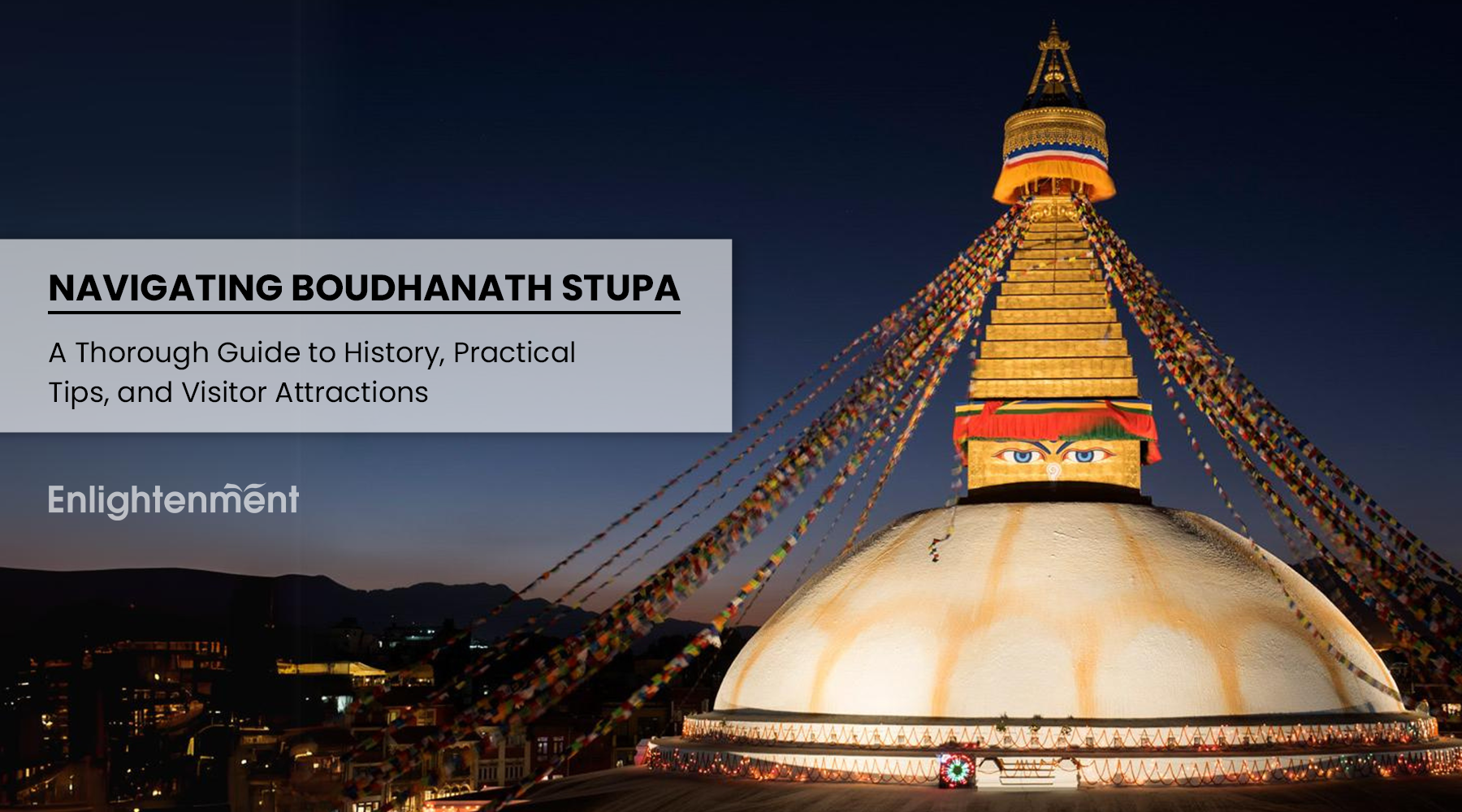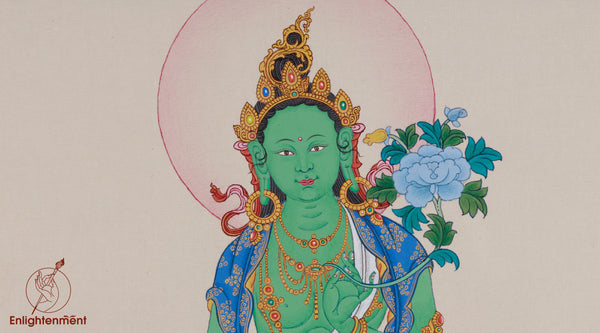Your Comprehensive Guide to Visiting Boudhanath Stupa
A visit to Boudhanath Stupa in Kathmandu is an extraordinary experience for anyone seeking spiritual depth, cultural richness, and architectural beauty. It is one of the largest stupas in the world, where Vajrayana Buddhism traces its origins. This sacred site is one of the UNESCO World Heritage Sites, making it a bustling tourist place.
But the stupa's significance extends beyond mere tourism; it is a place of devotion, where countless rituals and prayers are performed daily. It serves as a focal point for both Buddhist pilgrims and tourists alike. The stupa stands as a symbol of peace and enlightenment, attracting those who wish to connect with a deeper spiritual journey.
Here’s a detailed guide to help you make the most of your visit to this sacred site.
The Stupa is an Architectural Splendor With Spiritual Symbolism
The grand Boudha Stupa stands high and mighty, with its massive white dome and gilded spire topped by the all-seeing eyes of Buddha. The eyes of the Buddha on all four sides signify omniscience, and the 13 tiers symbolize the stages leading to enlightenment.

Hence, it is not just a monument; rather, it is a symbol of enlightenment that is associated with terma (hidden teachings).
The legend goes back to the revered Guru Padmasambhava; he had gained realization through symbolic practice in Yanglesho Cave in Pharping. He then secretly concealed Terma for rediscovery at the Boudha Stupa. This stupa is a physical form filled with physical treasures; hence, it is a power hub from which one can discover great spiritual insight.
While the history of the Stupa goes back to centuries, the most important part about it is that millions of devotees pay a visit to its premises to gain realization. Thus, Boudha Stupa also goes by one of its many epithets, the Wish-Fulfilling Gem.
People walk around the stupa in a clockwise direction as an essential part of the visit and spin prayer wheels embedded into the outer walls while chanting mantras. They hope to get a step closer to the divine and the serene energy by doing so.
Best Time to Visit and How to Get There
Boudhanath is accessible from central Kathmandu and is about 6 km from Thamel. You can either take a taxi or use local transportation as the location lies in an accessible part of the town. You will be greeted by big white gates, making it distinctive from its surroundings.
Best Time to Visit:
-
Early Morning: The stupa is serene, and the air is filled with the sound of chanting as monks begin their prayers.
-
Evening: As dusk falls, the stupa is illuminated, and the surrounding area comes alive with butter lamps and candlelight offerings. It’s a magical time to witness the devotion of pilgrims.
The entry fee for Boudhanath Stupa is typically around NPR 400 for foreign tourists. While Nepalese citizens can enter for free, SAARC nationals may incur a small fee. The price changes over time, so it is better to carry spare Nepali currency.
Exploring Surrounding Monasteries and Shrines
Boudhanath is not just the stupa itself but a vibrant Buddhist community. Surrounding the stupa are numerous monasteries (gompas), each with unique architectural designs and spiritual significance. Here are a few you must visit:
1. Guru Lhakhang Monastery
- Location: Just a short walk southeast of Boudhanath Stupa, situated along a quieter lane.
- Significance: Guru Lhakhang is dedicated to Guru Rinpoche (Padmasambhava) and serves as a center for Nyingma teachings. The monastery is known for its serene environment, making it a favored spot for meditation and spiritual practice.
2. Thubten Gyatso Monastery
-
Location: Located to the east of Boudhanath Stupa, near the main road leading into the area.
-
Significance: This monastery is part of the Gelugpa tradition and is known for its focus on scholarship and monastic education. Thubten Gyatso Monastery hosts various religious ceremonies and teachings, attracting both local practitioners and visitors.
3. Shechen Monastery
-
Location: Situated northwest of Boudhanath Stupa, not far from the bustling streets surrounding the stupa.
-
Significance: Shechen Monastery is one of the prominent Nyingma monasteries in the area and is known for its rich artistic heritage, including traditional thangka paintings and murals. It plays a crucial role in preserving Tibetan culture and offers a variety of teachings and community events.
Each of these monasteries enhances the spiritual landscape of Boudhanath Stupa, contributing to the vibrant cultural and religious life of the region.
As you walk around the stupa’s perimeter, don’t miss the small shrines dedicated to various deities such as Tara, Vajrayogini, and Chenrezig. These minor shrines are often visited by locals, and you can light a butter lamp or offer a prayer.
Pigeon Feeding Place
The pigeon feeding place at Boudhanath Stupa in Nepal is a popular spot for both locals and tourists. The area around the stupa is often filled with pigeons, which are considered sacred by many. Feeding the pigeons has become a common activity for visitors. This practice is not only a way to connect with nature but also a means of making merit in Buddhist culture.
The sight of the pigeons flocking around the stupa adds to the vibrant atmosphere, and it creates a serene setting where people can engage in reflection and meditation. The combination of the stupa’s majestic architecture, the spiritual ambiance, and the lively pigeons makes it a unique experience for those who visit.
You can find vendors selling the grains for feeding the birds.
Ajima Temple Is Worshipped For Fertility and Family
Ajima Temple is located approximately 200 meters southeast of Boudhanath Stupa. This shrine is dedicated to Ajima, the goddess of protection and fertility. This temple is particularly significant for local communities, as it embodies the blending of Buddhist and Hindu traditions in the area. Visitors often come to offer prayers for health, prosperity, and safe childbirth. The temple's vibrant architecture and serene atmosphere make it a peaceful spot for reflection, while the regular ceremonies attract both devotees and tourists alike, enhancing the spiritual fabric of the Boudhanath area.
Moreover, there is a way to enter the main stupa from the door next to Ajima Temple. This entrance allows visitors access to the area around the stupa. Typically, visitors can go up to the first floor of the stupa, where they can enjoy views of the surrounding area and engage in spiritual practices. However, access to certain higher levels may be restricted to preserve the sanctity of the site and for safety reasons.
Not to be Missed: Guru Rinpoche Park

Guru Rinpoche Park, located within the Boudhanath Stupa complex, is a serene and spiritually enriching space dedicated to the Second Buddha. The divine figure is credited with bringing Buddhism to Tibet in the 8th century and is highly regarded in Tibetan Buddhism for his teachings and contributions.
The park features a giant statue of Guru Rinpoche in a meditative pose. He sits high, and his surroundings are decorated with a small water tunnel for decorative fish. The surrounding is filled with benches and flowers for visitors to sit and soak in the peaceful radiance coming from the Guru's presence. The park provides a tranquil environment for meditation, contemplation, and relaxation. It’s an ideal spot for visitors to take a break from the bustling energy of the stupa.
Where To Go For Food and Drink
After a long walk around the Stupa and its nearby attractions, you may want to sit down and relax with good food and drinks. Luckily, there are several rooftop cafes and restaurants that offer panoramic views of the monument.
From the local foods to special cuisine-serving hotels and restaurants, you've got it all. Take location reference from Google and if you intend on exploring the local flavors, a short inquiry with the locals might be very helpful. Remember to be polite in the sacred area.
Shopping for Souvenirs: Visit to Enlightenment Thangka Studio

Your visit to Boudhanath would be incomplete without bringing home a meaningful souvenir. One of the best places to find authentic Buddhist art is Enlightenment Thangka Studio, located near the stupa. This studio offers a variety of exquisite thangkas. Each thangka is hand-painted by skilled artists, maintaining a high standard of quality and authenticity. Whether you're looking for a spiritual keepsake or an artistic masterpiece, the staff will guide you in selecting the right piece according to its symbolism and purpose. We also offer custom orders and shipping services if you wish to buy a large piece.
A visit to Boudhanath Stupa is a journey not just through physical space but also a deeply spiritual one. Whether you’re a devotee seeking blessings or a traveler captivated by its cultural and architectural significance, Boudhanath leaves a lasting impression. With its surrounding monasteries, authentic souvenir shops like Enlightenment Thangka Studio, and nearby temples, this UNESCO heritage site truly encapsulates the essence of Nepal’s rich Buddhist heritage.


